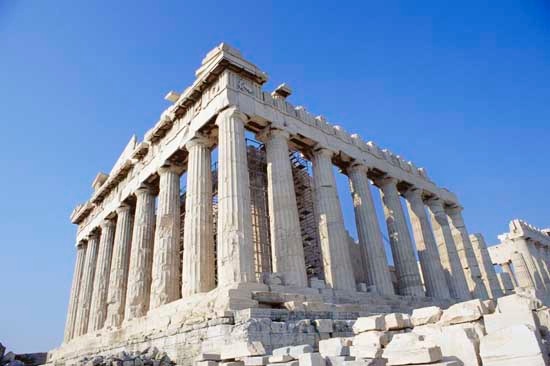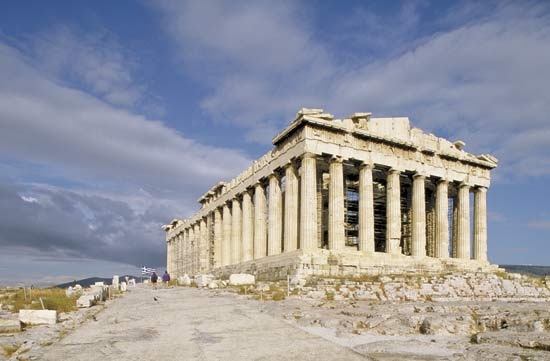Parthenon
temple, Athens, Greece
 chief temple of the Greek goddess Athena on the hill of the Acropolis at Athens, Greece. It was built in the mid-5th century BC and is generally considered to be the culmination of the development of the Doric order, the simplest of the three Classical Greek architectural orders. The name Parthenon refers to the cult of Athena Parthenos (“Athena the Virgin”) that was associated with the temple.
chief temple of the Greek goddess Athena on the hill of the Acropolis at Athens, Greece. It was built in the mid-5th century BC and is generally considered to be the culmination of the development of the Doric order, the simplest of the three Classical Greek architectural orders. The name Parthenon refers to the cult of Athena Parthenos (“Athena the Virgin”) that was associated with the temple.Directed by the Athenian statesman Pericles, the Parthenon was built by the architects Ictinus and Callicrates under the supervision of the sculptor Phidias. Work began in 447 BC, and the building itself was completed by 438 BC. The same year a great gold and ivory statue of Athena, made by Phidias for the interior, was dedicated. Work on the exterior decoration of the building continued until 432 BC.
 Although the rectangular white marble Parthenon has suffered damage over the centuries, including the loss of most of its sculpture, its basic structure has remained intact. A colonnade of fluted, baseless columns with square capitals stands on a three-stepped base and supports an entablature, or roof structure, consisting of a plain architrave, or band of stone; a frieze of alternating triglyphs (vertically grooved blocks) and metopes (plain blocks with relief sculpture, now partly removed); and, at the east and west ends, a low triangular pediment, also with relief sculpture (now mostly removed). The colonnade, consisting of 8 columns on the east and west and 17 on the north and south, encloses a walled interior rectangular chamber, or cella, originally divided into three aisles by two smaller Doric colonnades closed at the west end just behind the great cult statue. The only light came through the east doorway, except for some that might have filtered through the marble tiles in the roof and ceiling. Behind the cella, but not originally connected with it, is a smaller, square chamber entered from the west. The east and west ends of the interior of the building are each faced by a portico of six columns. Measured by the top step of the base, the building is 101.34 feet (30.89 metres) wide and 228.14 feet (69.54 metres) long.
Although the rectangular white marble Parthenon has suffered damage over the centuries, including the loss of most of its sculpture, its basic structure has remained intact. A colonnade of fluted, baseless columns with square capitals stands on a three-stepped base and supports an entablature, or roof structure, consisting of a plain architrave, or band of stone; a frieze of alternating triglyphs (vertically grooved blocks) and metopes (plain blocks with relief sculpture, now partly removed); and, at the east and west ends, a low triangular pediment, also with relief sculpture (now mostly removed). The colonnade, consisting of 8 columns on the east and west and 17 on the north and south, encloses a walled interior rectangular chamber, or cella, originally divided into three aisles by two smaller Doric colonnades closed at the west end just behind the great cult statue. The only light came through the east doorway, except for some that might have filtered through the marble tiles in the roof and ceiling. Behind the cella, but not originally connected with it, is a smaller, square chamber entered from the west. The east and west ends of the interior of the building are each faced by a portico of six columns. Measured by the top step of the base, the building is 101.34 feet (30.89 metres) wide and 228.14 feet (69.54 metres) long.The Parthenon embodies an extraordinary number of architectural refinements, which combine to give a plastic, sculptural appearance to the building. Among them are an upward curvature of the base along the ends and repeated in the entablature; an imperceptible, delicate convexity (entasis) of the columns as they diminish in diameter toward the top; and a thickening of the four corner columns to counteract the thinning effect of being seen at certain angles against the sky.
The sculpture decorating the Parthenon rivaled its architecture in careful harmony. The metopes over the outer colonnade were carved in high relief and represented, on the east, a battle between gods and giants; on the south, Greeks and centaurs; and on the west, probably Greeks and Amazons. Those on the north are almost all lost. The continuous, low-relief frieze around the top of the cella wall, representing the annual Panathenaic procession of citizens honouring Athena, culminated on the east end with a priest and priestess of Athena flanked by two groups of seated gods. The pediment groups, carved in the round, show, on the east, the birth of Athena and, on the west, her contest with the sea-god Poseidon for domination of the region around Athens. The entire work is a marvel of composition and clarity, which was further enhanced by colour and bronze accessories.
The Parthenon remained essentially intact until the 5th century AD, when Phidias's colossal statue was removed and the temple was transformed into a Christian church. By the 7th century, certain structural alterations in the inner portion had also been made. The Turks seized the Acropolis in 1458, and two years later they adopted the Parthenon as a mosque, without material change except for the raising of a minaret at the southwest corner. During the bombardment of the Acropolis in 1687 by Venetians fighting the Turks, a powder magazine located in the temple blew up, destroying the centre of the building. In 1801–03 a large part of the sculpture that remained was removed, with Turkish permission, by the British nobleman Thomas Bruce, Lord Elgin, and sold in 1816 to the British Museum in London. (See Elgin Marbles.) Other sculptures from the Parthenon are now in the Louvre Museum in Paris, in Copenhagen, and elsewhere, but many are still in Athens.
- Waikiki
- Wailua River
- Wailuku
- Waimakariri River
- Waimea
- Wainganga River
- Wain, John
- wainscot
- wainscot chair
- Wainwright, Jonathan M.
- Waipio Valley
- wairakite
- Wairau River
- wait
- Waitaki River
- Waitangi, Treaty of
- Waitemata Harbour
- Waite, Morrison Remick
- Waitomo
- Waits, Tom
- Waitz, Georg
- Waiuku
- Wajda, Andrzej
- waka
- wakan